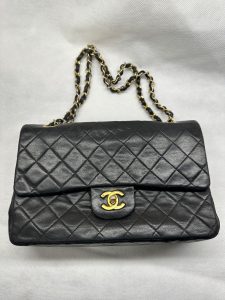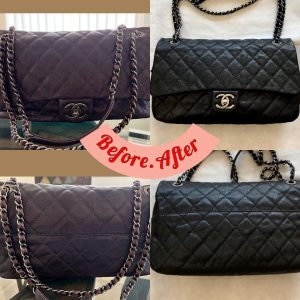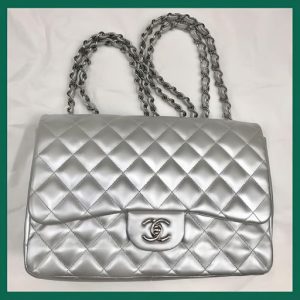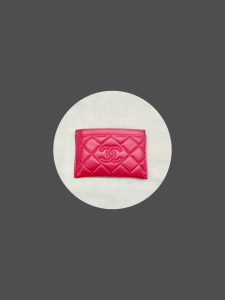WE ARE THE LEATHER EXPERTS
High End Handbag are timeless. When you buy at a second hand shop or online, use caution. If the quality is inferior or the bag has something about it, like it is too light weight, or the zipper wrong with the design. Trust your instinct, and get a second or third opinion, or simply walk away.
Notes to detect:
- If it’s a quilted bag, all the Quilting will match up all over the bag. Some sophisticated fakes can feature perfectly aligned diamonds, as well.
- Stitching on high end bags is small, refined and delicate. The stitching almost looks like a smooth line. Fakes, the stitching looks big and aggressive, like puncture holes because it’s made of plastic.
- Chain handles on high end handbag are plated in gold and have a heavy weight to it. Antique hardware on vintage bags aren’t plated in gold, but feel substantial and look well made. Fake chains feel lightweight and cheap like cheap jewelry.
- Interlocking CC Logo are interlocked and always appear right over left at the top, and left over right at the bottom.
- The Lining on the real high end handbag are lined in leather. The fake one see in the photo is lined in plastic.
- The Hologram Sticker has the serial numbers and a date code inside the bag. Sometimes the hologram stickers fall off of vintage or pre-owned high end handbag, but you can usually see the sticker’s adhesive residue where it was once located. Fake ones are missing details.
- The Gold Hardware features a small mark indicating that it’s gold plated hardware that is much more delicate marking and the fake ones look like it was carved in.
Here’s a great article:
“Here’s How to Spot the Difference Between Real and Fake Designer Bags”
LAURA GURFEIN Mar 10, 2015, 4:30p Photos by Driely S.
/cdn0.vox-cdn.com/uploads/chorus_asset/file/3489342/hermes-real-fake_2015_03.0.jpg)
Can you spot the fake Birkin above with just a glance*? Natalie Wyll and Alexa Ridolfi, the sisters who run A Second Chance Resale, do that for a living, thanks to a $600 billion counterfeit industry.
Along with their mother, who founded the Upper East Side store before expanding to Soho’s West Broadway, they’ve become experts at authenticating and valuing designer handbags—especially for the Big Three brands.
“When you purchase a luxury product, you get a lifetime guarantee. They are investment pieces. The value goes in some cases and others, keep their value. When you invest in a knockoff, you’re not investing in anything. You can’t resell it, and when the bag starts wearing or falling apart, you’re at a loss. It’s a throw away.” ~ John Slater, Auctioneer
Wyll and Ridolfi gave us side-by-side comparisons of authentic and counterfeit bags from these brands, pointing out the subtlest of differences that can determine whether they’ll spend upwards of tens of thousands of dollars to purchase a bag from a consignor.
/cdn0.vox-cdn.com/uploads/chorus_asset/file/3490528/DrielyS-4195.0.jpg)
Chanel
The Boy Bag, pictured here, is one of Chanel’s most popular purses, a modern take on a classic style. “It’s one of the most expensive bags they sell, and they’re really hard to get in stores,” which makes it a hot commodity on the resale market—and the counterfeit market, too. Just by looking at the pictures above and below, can you tell which bag is real?
/cdn0.vox-cdn.com/uploads/chorus_asset/file/3490670/DrielyS-4391.0.jpg)
(Answer: It’s the first one.)
Fake producers have gotten really good at mimicking the outside of the bag, so the sisters usually look for clues on the inside.
/cdn0.vox-cdn.com/uploads/chorus_asset/file/3490584/chanel-card_2015_03.0.jpg)
Reminder: Just because a bag comes with an authenticity card doesn’t actually make it authentic—counterfeiters fake those, too In fact, you should always be wary of authenticity cards when buying outside of a brand’s official store: Louis Vuitton and Hermès bags don’t have them, Wyll explained, but fakers will lure unassuming customers with them anyway.
In this case, Wyll could spot the fake bag on the bottom based on her brand knowledge. “I can see that this has a hologram to it,” while authentic authenticity cards just have a gold trim. Other inconsistencies include the font size, the type used for the bag number, and the fake-looking symbol sticker on the upper right corner.
/cdn0.vox-cdn.com/uploads/chorus_asset/file/3490646/chanel-inside-tag.0.jpg)
Regarding the hologram on the card, “this mistake was probably made [by the counterfeiter] because they have something inside them called a hologram sticker, which is what the card number is supposed to match,” Wyll explained. The manufacturer of the fake bag likely confused the terminology, which accidentally outed his product.
/cdn0.vox-cdn.com/uploads/chorus_asset/file/3490738/chanel-tag.0.jpg)
Another tiny but important clue? The inside label—notice how the top of the text isn’t parallel to the stitching on the right? It slopes down just ever so slightly, but real Chanel product inspectors wouldn’t let a detail like this slide.
/cdn0.vox-cdn.com/uploads/chorus_asset/file/3489970/DrielyS-4115.0.jpg)
Louis Vuitton
At first glance, a counterfeit Louis Vuitton bag can easily pass as real. “Maybe the color might be a little off, but if you don’t have it side-by-side [with a real bag], it’s hard to really notice,” Ridolfi said. The above bag is authentic, but below is a counterfeit—hard to tell, right?
/cdn0.vox-cdn.com/uploads/chorus_asset/file/3490692/DrielyS-4335.0.jpg)
Plus, “the color changes over the years,” according to Wyll. In this Damier print, which has been around since the ’80s, “sometimes it has like a green undertone. Maybe someone would look at and think it’s fake, but it’s not—it’s older. It’s just different.”
/cdn0.vox-cdn.com/uploads/chorus_asset/file/3490016/DrielyS-4185.0.jpg)
A big indicator is whether the bag has a proper identification stamp. The letters are code for the country in which the bag was made, while the numbers indicate when it was made. The second and fourth numbers stand for the year (so 2008, in this case), while the first and third numbers are for the week in that year (here, the eleventh week).
“First, Louis Vuitton was doing the month and the year” in the stamp number, Wyll said. “Then the counterfeiters caught on, so now they do the week of the year—a number out of 52 instead of a number out of 12—to throw them off. Also, they started assigning different letters to different regions. CA is not the only two-letter [combination] that is associated with Spain, for example. You could have CA and, like, five other different letter combinations mean Spain.
“It makes our job difficult, too,” she added. “You perfect something, and then they change it because the counterfeiters are on top of it, too.” That’s why a lot of the stamps on fake bags are the same as the real ones—so if the stamp looks correct, hunt for other inconsistencies.
/cdn0.vox-cdn.com/uploads/chorus_asset/file/3490150/louis-vuitton-outside-stitch.0.jpg)
Stitching, for example, can always be a clue. “We look at the stitching really closely,” Ridolfi said. “Something that’s different in these two is the stitching on the fake bag [right] is sloppy and not really straight.” The stitching is also pressing too tight into the material, making it look cheap.
/cdn0.vox-cdn.com/uploads/chorus_asset/file/3490184/DrielyS-4367.0.jpg)
Sometimes, the poor stitching isn’t even readily visible. The bag above gives itself away as a fake by using a different color thread underneath this tab. “Counterfeiters hide it under there,” Wyll said. Added Ridolfi, “That’s just weird and inconsistent … [Louis Vuitton] wouldn’t pull in a different color thread for just two stitches.”
/cdn0.vox-cdn.com/uploads/chorus_asset/file/3490234/louis-vuitton-zipper.0.jpg)
Again, any little detail that’s less than perfect can be a red flag. The fake Louis Vuitton bag the sisters brought, for example, had problems with the leather tab on its zipper pull [left]. “You can see how there’s extra fabric here?” Ridolfi asked. The gold fastener attaching the tab to the zipper is “always really close,” she explained. “That’s a big key right there.”
/cdn0.vox-cdn.com/uploads/chorus_asset/file/3489288/hermes-label-stamp_2015_03.0.jpg)
Hermès
First, check out the label stamp on the top of the bag. “You can’t see too much of a difference here, but the stamp…is pretty high and close to the stitching” on the authentic Birkin (left), Ridolfi said. “If you see it in the middle” between the stitching and the lock, that’s a dead giveaway. Note how the stamp on the fake bag also appears to sit on top of the leather, while the authentic stamp is really a part of the fabric.
“You also want to make sure [the stamp] is straight,” Wyll added—remember, this detail was a giveaway on the Chanel label. “These are little details, but they make a difference.”
/cdn0.vox-cdn.com/uploads/chorus_asset/file/3489400/hermes-blind-stamp_2015_03.0.jpg)
Next, undo the lock and pull back the arm to reveal the blind stamp. “Every Hermès bag is handmade by one artisan, so they put their own trademark [stamp] on it, along with the blind stamp,” which indicates the year it was made, Wyll explained. But the presence of the stamp alone might not distinguish a counterfeit. “This fake has a blind stamp and it has an artisan stamp. They knock off everything—serial numbers and all.”
So in a case like this, look at the stamp’s quality. “It’s very deep, like it was machine-stamped,” Ridolfi noticed of the fake bag (top), and it’s a larger size than a real stamp. On the real bag (bottom, with close-ups of each stamp), it’s “much fainter,” Wyll pointed out. “You can hardly see it from where you’re standing.”
/cdn0.vox-cdn.com/uploads/chorus_asset/file/3489616/fake-birkin.0.jpg)
Even if you don’t have a certified authentic bag to compare a suspect against, you can be on the lookout for any inconsistencies on details like hardware. “There’s always going to be one place where it’s just not consistent with the quality of the brand, and a lot of times it’ll be in the hardware.” said Wyll of the counterfeit bag above.” For instance, I can tell that this hardware is plastic—It doesn’t get cold, and it feels lighter.”
And once again, stitching was a factor that revealed the fake’s identity. “At first glance, this looks stitched neatly,” she said. “But if you start looking at finer details—edges and corners—you’ll notice around here the stitching gets sloppy. Those are inconsistencies that you won’t find in an authentic bag. It’s going to be neat and consistent throughout.”
Same goes for the paint, even on a nearly microscopic level. “There’s a little bit of sloppiness, paint that’s transferred over on the edge here. And sometimes people will think, ‘Oh it’s hand-painted so, that allows for [inconsistencies].’ Not with Hermès. They’re perfectionists.”






